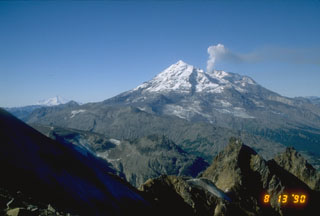Report on Redoubt (United States) — 1 October-7 October 2008
Smithsonian Institution / US Geological Survey
Weekly Volcanic Activity Report, 1 October-7 October 2008
Managing Editor: Sally Sennert.
Please cite this report as:
Global Volcanism Program, 2008. Report on Redoubt (United States) (Sennert, S, ed.). Weekly Volcanic Activity Report, 1 October-7 October 2008. Smithsonian Institution and US Geological Survey.
Redoubt
United States
60.485°N, 152.742°W; summit elev. 3108 m
All times are local (unless otherwise noted)
AVO reported that on 16 September, a pilot flying downwind of Redoubt reported smelling a strong sulfur dioxide odor. A week later, residents of a cabin near Wadell Lake (25 km NE) reported loud noises coming from the direction of Redoubt. During an overflight on 27 September, scientists observed several fractures and circular openings in the upper Drift glacier that had not been seen before. They also noted that fumaroles atop the 1968 and 1990 lava domes were more vigorous than when last observed in mid-August. A distinct hydrogen sulfide odor was also evident, though no sulfur dioxide was detected by onboard instrumentation. The seismic network at Redoubt did not detect any abnormal earthquake activity. The Volcano Alert Level remained Normal and the Aviation Color Code remained Green.
Geological Summary. Redoubt is a glacier-covered stratovolcano with a breached summit crater in Lake Clark National Park about 170 km SW of Anchorage. Next to Mount Spurr, Redoubt has been the most active Holocene volcano in the upper Cook Inlet. The volcano was constructed beginning about 890,000 years ago over Mesozoic granitic rocks of the Alaska-Aleutian Range batholith. Collapse of the summit 13,000-10,500 years ago produced a major debris avalanche that reached Cook Inlet. Holocene activity has included the emplacement of a large debris avalanche and clay-rich lahars that dammed Lake Crescent on the south side and reached Cook Inlet about 3,500 years ago. Eruptions during the past few centuries have affected only the Drift River drainage on the north. Historical eruptions have originated from a vent at the north end of the 1.8-km-wide breached summit crater. The 1989-90 eruption had severe economic impact on the Cook Inlet region and affected air traffic far beyond the volcano.
Source: US Geological Survey Alaska Volcano Observatory (AVO)

